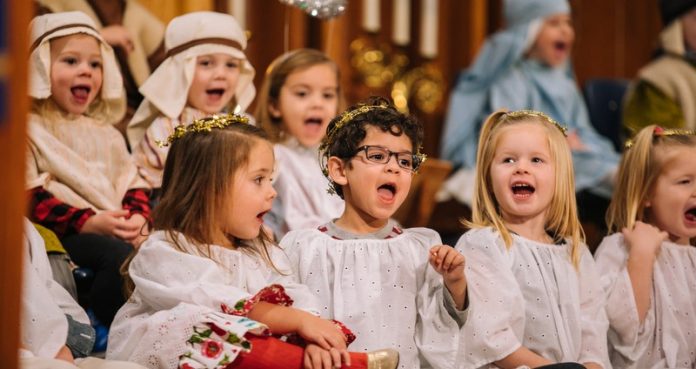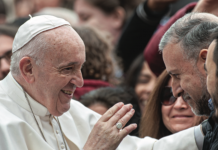
MARLENE SWEENEY
How many Christmas carols do our children know? Yes, they know the songs about Rudolph, Frosty, and jingle bells. But the first time our parish music minister introduced “O Little Town of Bethlehem,” catechists were amazed at how many children admitted to never having heard the melody or knowing the words.
Teaching traditional Christmas songs, along with the stories that are enfolded in the lyrics, can turn out to be a favorite lesson each year. This is true, of course, for the songs of Advent and Lent.
Children Love to Sing
Watching the primary-grade boys and girls learning the playful songs and motions at vacation Bible school set off a new vision for me as a Director of Religious Education. Why couldn’t we harness this enthusiasm and energy for music into our religious education curriculum all year long? How could we take this love of song into our liturgies and teach song as prayer?
After all, if religious education did not teach children the music of our tradition, where would they learn it? Were we destined to raise a generation of passive listeners while only trained choirs are called upon to lead song? Was there still merit to the entire community blending their voices of numerous pitches and keys, all singing one song of praise?
Start at the Very Beginning
Having no formal music training myself, I could easily have felt intimidated by the thought of adding music to the curriculum. Instead, I relied on my passion to begin a conversation with the parish music director and the pastor as to how we might proceed.
Both the music director and the pastor fully endorsed the idea of introducing the children to different experiences of music within our tradition, as participants and/or observers depending on their age level. While we agreed most school-age children were ready to be introduced to the parish hymnals, invitations to join the hand-bell choir might not come until junior high or later.
Because the music director already had a full schedule, she offered the names of musicians and choir members in the parish who had teaching backgrounds, who might be willing to volunteer in our children’s ministry and help launch this new project. Since our program met three different days of the week, that first year I sought three different volunteers so as to not burden any one person. In subsequent years, I sought out music ministers for teaching by age levels rather than days of the week.
The Rise of Competent Volunteers
What I learned quickly was that my own passion for this idea fanned the flames of musically talented parishioners who also were eager to see children learn to praise God with song and to join with the adult community singing at liturgies. Soon I had competent volunteers offering to teach liturgical responses, Taizé prayer, praise songs, and percussion instruments. One volunteer even offered to put together a children’s choir. It was clearly an idea filled with possibilities.
After listening to the concerns of the catechists—who understandably lamented the limited time they had to spend with their groups—we decided to start simple. Once a month, groups spent half of one session in music formation. This involved working with a music minister in another location, usually in the church but sometimes in the gym. We rotated days by grade level, and everyone had an opportunity to participate.
Because not every adult embraced “music practice” (as they often called it) to be a good use of religious education time, I realized the importance of emphasizing the value that we as a community placed on teaching our children the music of our tradition. I encouraged everyone to reserve judgment until we had experienced a full year of our new venture.
Sing, Sing Along
Before long, catechists started appreciating how much music enhances many of the lessons.
For example, they began using the CDs that many publishers include with their teachers’ manuals—meant to supplement lessons. Prior to that, many catechists admitted to not feeling comfortable leading their group in song, and so the CDs had not been used. Because a resource person now was available to answer questions and offer insights, catechists began to use the CDs in their sessions. Also some of those popular VBS songs reappeared when we met those same Scripture stories in the Lectionary. The joy of singing started to find its way into lesson plans on many levels.
As the music ministry evolved within our religious education program, I came to appreciate how St. Augustine believed that when we sing we pray twice. There was a noticeable deepening of ritual and worship through song. Listening to over two hundred children blending their voices is truly “making a joyful noise onto the Lord.”
Marlene Sweeney, M.Ed., MA, is a Certified Pastoral Associate in the Archdiocese of Chicago. Marlene is a writer and poet whose works have appeared in numerous books and periodicals.
This article was originally published in Catechist magazine, October 2011.
Image Credit: Tucker Good on Unsplash




